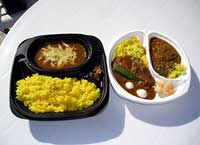|
|
|||||||
|
|
|||||||
|
|||||||
| | Web Japan >> | Trends in Japan >> | Business & Economy >> | Leisurely Lunches | |
|
LEISURELY LUNCHES Stalls Offer Tokyo Workers a Fresh Way to Refuel (December 7, 2004) For many of Japan's office workers, lunchtime involves either squeezing into a packed restaurant offering limited and relatively cheap meals or eating a bento boxed lunch at a desk. Workstore Tokyodo Inc., however, aims to offer a more relaxing and eclectic alternative. The company operates Neo Yatai Mura, or "villages of neo food stalls," in several spots in central Tokyo. These consist of clusters of around a half dozen colorfully decorated food stalls parked in open spaces in office districts, where lunch-goers can relax in alfresco surroundings. The "villages" offer office workers a chance to refuel both physically and mentally in preparation for their afternoon's work. Culinary Oases One of the "villages" is located at the Tokyo Sankei Building's Metro Square, not far from Tokyo Station in the Otemachi district. Another one can be found a few blocks away at the Tokyo International Forum, in the Marunouchi district. The stalls offer the usual lunchtime favorites, such as curry with rice, sandwiches, coffee, soup, and rolled sushi. But also on offer are more exotic dishes, including a Hawaiian platter, Thai curry, tacos, Vietnamese spring rolls, or Greek-style kebabs. All main dishes are reasonably priced at around ¥600 ($6 at 100 yen to the dollar), with a variety of side dishes also available. The atmosphere tends to be a lot more casual and friendly than at most office-district restaurants. It is common for stall operators to chat and joke with customers, and there is sometimes entertainment to go with the food, with performances and exhibits scheduled at the sites during lunchtime. Stalls serving food and drink are nothing new in Japan. Traditionally, however, the stalls have been rather rustic nighttime hangouts where customers eat some ramen noodles or oden (various foods simmered in stock) accompanied by beer, shochu (distilled spirits), or sake. Stalls specializing in serving up lunches - and exotic ones at that - are clearly an innovation. The stall-village model also differs from the armies of little trucks, long a feature of office districts in Japan at lunchtime, which sell prepared bento boxes. The "village" stall operators, by contrast, cook and prepare the dishes on the spot, using ranges and other equipment fitted to their stalls. The business model offers a number of benefits for those who aspire to run their own small enterprise. "I chose the yatai approach because I was attracted by the cheap startup investment and the fact there are no building-related fixed costs," says stall operator Mikajiri Ken. Mikajiri left a salaried position in the IT business to run his curry-rice stall, named South Park, which he parks in front of the Sankei Building. Even so, as a purveyor of one of Japan's favorite lunchtime dishes, he finds himself constantly facing stiff competition. "In order to keep my regular customers, I need to innovate. Still, doing the thinking is part of the fun," he says. As with the other stall operators, Mikajiri is registered with Workstore Tokyodo. Plenty of Support for Stall Operators Also offering support are companies that produce the stalls' colorful decorations, such as stickers and banners. Thanks to such help, even young people find it easy to run their own food stall. It's also easier than in the past for stall operators to set up shop in locations that receive a lot of human traffic. Whereas in the past such stalls may have been seen as a nuisance, building management companies now positively welcome attractions that will draw customers to their areas. One of the stall villages is located just outside Tokyo's city center in the Nakameguro district, alongside the Meguro River. Calling itself Midoribashi-mura, it offers customers a ¥100 (about $1) discount after 1:00 p.m. With their ever-changing menus of freshly prepared, appetizing lunches, the stall villages are sure to continue gaining popularity among the millions of office workers that populate the capital on weekdays. It seems that more and more workers are keen to relax during their lunch breaks, rather than rush. Copyright (c) 2004 Web Japan. Edited by Japan Echo Inc. based on domestic Japanese news sources. Articles presented here are offered for reference purposes and do not necessarily represent the policy or views of the Japanese Government. |
FROZEN SUSHI (March 30, 2004) SMALL-TOWN NOODLE MAKES GOOD (January 16, 2004) THE SOUND OF SILENCE (October 17, 2003) |
|
|




